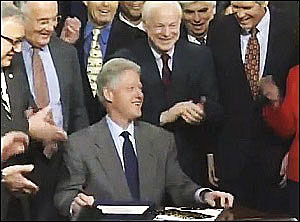By Pam Martens and Russ Martens: February 23, 2016

President Bill Clinton Laughs It Up as He Signs the Repeal of the Glass-Steagall Act, November 12, 1999
Thanks to the Presidential debates, most Americans have heard of the Glass-Steagall Act which kept the country’s banking system safe for 66 years until it was repealed by President Bill Clinton in 1999, allowing the risky activities of Wall Street trading firms to merge with insured-deposit banks, setting the stage for the Wall Street collapse in 2008. But few Americans have ever heard of the Riegle-Neal Interstate Banking and Branching Efficiency Act of 1994, which Bill Clinton signed into law less than two years after taking office. The Riegle-Neal legislation allowed bank holding companies to acquire banks anywhere in the nation and invalidated the laws of 36 states which had allowed interstate banking only on a reciprocal or regional basis.
Put these two pieces of legislation together with the Commodity Futures Modernization Act of 2000, also signed into law by Bill Clinton, which allowed trillions of dollars of OTC derivatives on Wall Street to escape regulation, and you have just defined America’s current banking system from hell.
In 1934, there were 14,146 commercial banks with FDIC insurance in the United States. By 1985, that number had barely budged – we had a total of 14,417. But as of this month, we have 6,172 FDIC-insured commercial banks, a decline of 57 percent, with the annual declines accelerating after the passage of Riegle-Neal in 1994.
Making the banking system decidedly grim in terms of both competition and the potential for more taxpayer bailouts, of the current 6,172 banks holding a total of $15.9 trillion in assets, just four banks (JPMorgan Chase, Bank of America, Wells Fargo and Citibank, a unit of Citigroup, hold 41 percent of those assets – rendering them too-big-to-fail and an albatross around the neck of the country’s economic prospects and the taxpayers’ pocketbook. (All four of the banks took billions of dollars under the Troubled Assets Relief Program during the 2008-2010 financial crisis and Citigroup received the largest bank bailout in U.S. history: $45 billion in equity infusions, over $300 billion in asset guarantees, and more than $2 trillion in cumulative, below-market rate loans from the Federal Reserve — loans that were initially kept secret from the taxpayer.)
By allowing these mega banks to gobble up banks all over the country and stick their logo on thousands of insured-deposit branches across America, Bill Clinton effectively created too-big-to-fail. And because these same handful of banks are dangerously interconnected as counter-parties to trillions of dollars in opaque derivative gambles, when the stock market sinks their share prices sink in tandem, raising ongoing worries of another banking contagion similar to 2008.
According to a report from the Office of the Comptroller of the Currency (OCC), just five Wall Street banks hold 93 percent of $247 trillion in notional derivatives at all U.S. banks. Those banks are: Citigroup, JPMorgan Chase, Goldman Sachs, Bank of America and Morgan Stanley. All of these banks have paid big fines for ripping off investors and/or consumers.
Bill Clinton ran for president on a platform of being out to help the little guy. Hillary Clinton’s presidential campaign web site says she “wants to be a champion for everyday Americans.” But the wrecking ball that Bill Clinton took to investor protection banking legislation during his two terms as President, the millions of dollars that have flowed from Wall Street into both Hillary Clinton’s campaign coffers and her personal bank account from speaking fees, should tell voters all they need to know.
It is highly likely that the U.S. will face another banking crisis in the not too distant future. How that crisis will be handled will determine the economic future of America for our children and future generations. With all that’s at stake, isn’t it time to judge candidates for high office on their actions and not their hollow promises?

